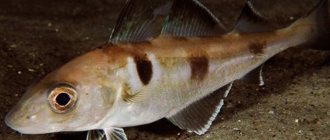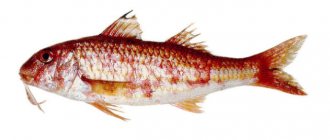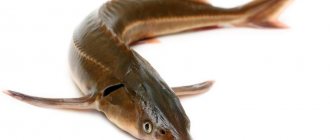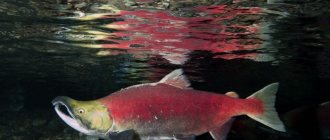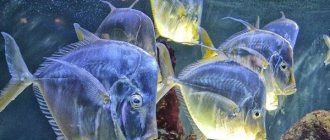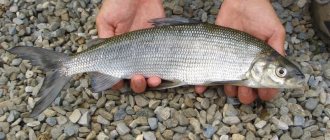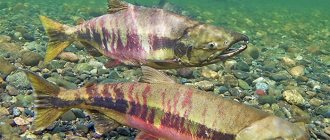The difference between seafood and freshwater inhabitants in cooking is colossal.
They differ strikingly in taste, and not every recipe for preparing river fish is suitable for seafood, and vice versa. Market counters are filled with fish called sole. Tilapia, which is most often sold under this enticing name, has never seen the sea. How to distinguish saltwater fish from pangasius or other freshwater species? What tastes better?
- Tilapia 86%, 38 votes
38 votes 86%38 votes - 86% of all votes
- Pangasius 14%, 6 votes
6 votes 14%
6 votes - 14% of all votes
Total votes: 44
16.01.2020
×
You or from your IP have already voted.
How to distinguish pangasius from sole
Solefish and pangasius are completely different fish, even belonging to different orders. It is simple to distinguish them externally: the sole, being a flounder-like fish, has a characteristic flat body structure. But since most often the buyer is already dealing with processed fish meat in the form of fillets, the differences may not be noticeable at first glance.
Sea sole fillet is exclusively white in color and is almost transparent. The color of pangasius fillet can vary from white-pink to grayish, while it always has pink areas, which are never found in sole.
In addition, the fillet of the sole is always thin, because this fish is flat. There is no fishy smell in sole fillets. Also, there are no fatty layers in the sole fillet.
Pangasius composition
The vitamin composition of pangasius (calculated per 100 g of weight) is as follows:
- vitamin PP – 2 mg;
- vitamin C – 1.2 mg;
- vitamin E – 1 mg;
- vitamin B1 – 0.2 mg;
- vitamins B2 and B6 – 0.1 mg each.
The fish contains easily digestible cholesterol in the amount of 70 mg.
Microelements included in fish:
- potassium – 240 mg;
- calcium – 50 mg;
- phosphorus – 210 mg;
- magnesium – 20 mg;
- iron – 1 mg;
- chromium – 55 mcg;
- iodine – 50 mcg;
- fluoride – 25 mcg.
In terms of the content of many microelements, pangasius is not inferior to most marine fish.
Chemical composition and benefits
The calorie content of sole is only 88 kcal per 100 g. It contains 10.3 g of protein, 5.2 g of fat, and no carbohydrates. Although its meat is lean, it contains healthy fatty acids that help eliminate the effects of a diet unbalanced in animal fats. The meat of this fish is rich in cobalt, which also helps fatty acids fight atherosclerosis. Another important microelement is chromium, which enhances the effectiveness of insulin. This is an ideal food for losing weight. It has everything to normalize carbohydrate-fat metabolism.
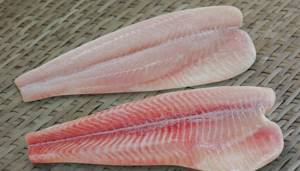
The product is rich in phosphorus, potassium, fluorine, iodine and vitamins A, E and almost all representatives of the extensive B group - and even folic acid, the source of which is usually recommended from plant foods. The high content of easily digestible protein makes it dietary.
How is pangasius useful?
The benefits of pangasius fillet, due to the elements it contains, are as follows:
- improvement of brain activity and memory (thanks to phosphorus and fats);
- normalization of skin condition (vitamins and fats);
- improving the structure of hair and nails, increasing their strength (amino acids and calcium);
- strengthening bones, joints and teeth (calcium, phosphorus);
- restoration of functions of the musculoskeletal system (polyunsaturated fats);
- preventing the early development of joint diseases, in particular osteoporosis;
- prevention of early aging (antioxidants and polyunsaturated fats).
There is an opinion among nutritionists that regular consumption of fillet improves sleep and increases stress resistance.
Pangasius fish: benefits
1. Phosphorus will help improve memory, attention, and brain activity.
2. Vitamins and amino acids will improve the condition of the skin, hair, and nails.
3. Calcium and phosphorus will strengthen bone tissue, joints, and restore the functions of the musculoskeletal system. Prevents the early development of joint diseases, such as osteoporosis.
4. Polyunsaturated fatty acids and antioxidants will slow down all aging processes of the body as a whole, normalize the functioning of the gastrointestinal tract, remove waste and toxins from the body, and improve metabolism.
5. Regular consumption of pangasius fillet will increase stress resistance, improve sleep, and relieve depression.
6. Vitamin A will take care of your vision, and is also necessary for the proper development of the child’s body.
7. Rich in proteins, it will be useful for people with an active lifestyle and intense physical activity. It is recommended to use to restore vitality after operations and serious illnesses.
8. The low glycemic index allows diabetics to consume it.
9. It is recommended for use by older people to prevent heart attacks and strokes, as well as to strengthen bones.
Is pangasius beneficial for pregnant and lactating women?
If the meat meets the standards and does not contain heavy metal salts, it can be consumed during pregnancy, but this use will not be a recommendation.
On the other hand, fillet contains quite a lot of iron and other trace elements that have a beneficial effect on the circulatory system, which makes it possible to use their beneficial properties in the prevention of anemia.
Another beneficial property of fillet is the presence of a sufficient amount of chromium, which is used as a regulator of insulin production in the body. Thereby helping mother and baby normalize glucose metabolism in the body.
However, the very high risk of getting a low-quality product, as well as the relative difficulty in assimilation even by a healthy body, make this fish undesirable during pregnancy or lactation.
LiveInternetLiveInternet
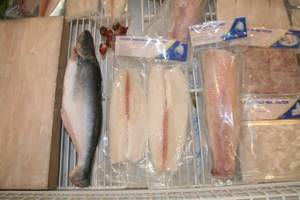
Nowadays you can find a wide range of frozen fish on store shelves. One of the species is pangasius or, as it is also called, sole. Pangasius is sold in the form of fillets, which is very convenient, and at the same time has a low price, which makes it a very affordable product. This fish is exported from Vietnam. In some countries in America and Europe it is prohibited to eat pangasius. Why? - the question arises. Firstly, pangasius is a river fish, and not a sole! The thing is that fish sellers deliberately confuse buyers by calling pangasius a seafood to increase demand for this product. Buyers who are not very knowledgeable about the types of fish believe the name and willingly buy fatty, tasty fish. But this is not a sole - it costs many times more than pangasius, and not everyone can afford to buy it.
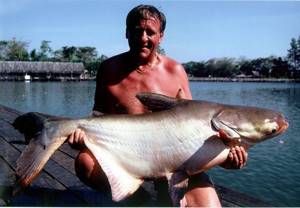
sole Secondly, pangasius fish is grown in artificial conditions on the Mekong River in Vietnam, which is one of the most polluted rivers in the world. Thirdly, steroids, plant and protein components are added to fish food, and they are fed hormones, which is very harmful to the human body. All this far from useful composition was found during a chemical study of fish. Eating this fish can lead to a number of diseases of the human liver and internal organs. Do you know that in order to increase sales of pangasius, some unscrupulous manufacturers add minced meat of this fish to “crab sticks”?
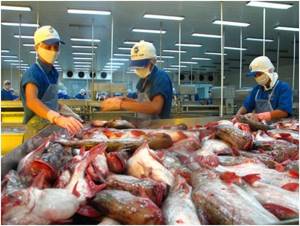
For transportation, pangasius is covered with an ice glaze, which contained a large amount of phosphates during chemical analysis. During such transportation, the fish often arrives on the shelves of poor quality. But we can also highlight the beneficial properties of pangasius. Sellers of high-quality pagasius must have all the documents for this particular fish, licenses and sanitary inspections of the fish. If pangasius is grown in environmentally friendly conditions, it is healthy: it contains B vitamins, vitamins PP, A, C, E. Pangasius contains macroelements - calcium, sulfur, potassium, phosphorus, magnesium, sodium and microelements - zinc , iron, chromium, fluorine. Pangasius differs from other fish in its high content of Omega-3 fatty acids and proteins. Pangasius fillet is used in cooking for preparing first and second courses, for baking in the oven and frying.
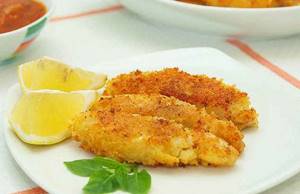
So decide for yourself whether to eat or not. Do not hesitate to ask the seller for all the documents for this particular fish, pay attention to the country of origin and supplier, and do not risk your health, do not buy fish from dubious sellers without documents! source
Is it possible to give pangasius to children?
There is no doubt that this product has a positive effect on the child’s body. It contains a large amount of phosphorus and calcium, due to which children’s skeletal system is strengthened and the functioning of the nervous system is improved.
Important!
Like any other fish product, it can be consumed by children starting from the age of three.
However, do not forget about the origin of this product. Therefore, before giving pangasius fillet to a child, you should weigh the pros and cons. In addition, it is advisable to do this after consulting a pediatrician or doctor.
Also, small bones, which abound in pangasius meat, pose a relative danger to children. Therefore, when feeding it to small children, you should carefully examine the pieces of meat and, if possible, get rid of small bones.
How to cook delicious pangasius
Fish goes well with many other foods and can be prepared in a variety of ways. There are more than a hundred recipes that include pangasius: from soups and main courses to pies and rolls.
Mostly fish is cooked together with vegetables, generously seasoned with herbs. It can be baked in batter or sour cream. The fillet can also be grilled and served in a variety of wines.
Actually, there are practically no incompatible combinations of products that include pangasius. This is what explains its great popularity.
If you found this article useful, please like and subscribe to our channel. Don't forget to share information with your friends on social networks.
Source of the article: https://zen.yandex.ru/media/poleznii_site/ryba-pangasius-polza-i-otzyvy-5c909d3a0b236a00b3a5b63c
Why is Telapia called trash fish?
Since this type of fish is omnivorous, it is not demanding of a particular habitat. It is not difficult for producers to feed tilapia with cheap feed, but this is not at all the main reason for its danger to human health.
Feeding with antibiotics, pesticides and GMOs
Basically, fish farming takes place in artificial reservoirs, where there is a high content of antibiotics and pesticides. No manufacturer will lose an entire batch of fresh tilapia due to some kind of disease. Also, instead of high-quality food, fish are fed GMOs to preserve their appearance and life expectancy. After taking samples, experts found a huge amount of dangerous substances.
History of appearance
It is very difficult to track where fish were caught, which may have higher levels of toxicity than ocean fish. The habitat of telapia is the rivers of Asia, which cannot boast of cleanliness.
Lack of Omega-3
Fish is considered healthy when it contains Omega-3. Unfortunately, telapia cannot boast of this. And all because when growing the fish adheres to a special diet, which is why it grows by leaps and bounds.
Reasons why you should not eat pangasius fish
The fish is grown in the Mekong River, which is located in Vietnam. It is considered one of the dirtiest rivers in the world. The fact is that water is often drained into the Mekong from chemical plants, sewer pipes or fields.
Pangasius is frozen in the same river. In order to speed up the growth process, producers use hormones that are injected into females. In addition, the fish are fed with GMOs and other chemicals harmful to human health.
This species is prohibited for sale in many countries in Europe and America. Experts found that the fish contained a high content of ice glaze, and also identified E. coli and Listeria bacteria.
The food and waste products of fish in such a habitat rot and give the meat a rotten smell. Doctors do not recommend consuming pangasius, because it can lead to liver damage, blood disease and other human organisms. Fish is also very dangerous for small children.
Source of the article: https://rsute.ru/781352-prichiny-otkazatsya-upotreblenie-v-pishhu-ryb-tilapii-i-pangasiusa.html
Is it possible to eat sole
It is safe to consume saltwater only if it is caught in a clean place. Often water bodies flowing in large cities are polluted by sewage, fertilizers from fields, and emissions from factories. The introduction of such products into the diet is fraught with damage to the liver and gastrointestinal tract.
What a taste
The flesh of the sole is tender, melts in the mouth, with a delicate taste. No wonder it is served in good French and Italian restaurants.

Are there bones
The flesh of the sole is tender, melts in the mouth, with a delicate taste. No wonder it is served in good French and Italian restaurants.
What are the benefits of fish?
By feasting on sole, you will receive an incredible amount of useful substances:
- vitamins (A, E, D, group B);
- micro- and macroelements (iodine, fluorine, calcium, manganese, zinc, copper, iron, phosphorus);
- amino acids;
- Omega-3 fatty acids, 6.
By consuming “fish-salt”, you can help the body remove toxins, regulate metabolism, and normalize the condition of blood vessels. The product is low in cholesterol. The properties do not end there: it strengthens joints, the nervous system, has a beneficial effect on diseases of the thyroid gland, and prevents the occurrence of stroke, atherosclerosis, and psoriasis.
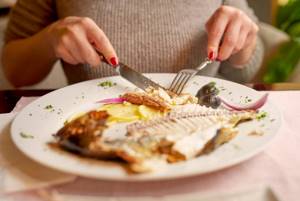
Sea sole cooked in the oven
For those with seafood allergies, salt may be harmful. In addition, the use of “fake”, which is sometimes sold under the guise of sea tongue - pangasius - does not promise any particular benefit. The fact is that this freshwater fish is caught in the Mekong, one of the dirtiest rivers in the world. Therefore, the pulp accumulates toxins and heavy metal salts. The situation is no better with farm pangasius: it is “pumped up” with high-calorie food, the composition of which is of great concern. It is not for nothing that the consumption of this fish is prohibited in a number of European countries.
Fatty fish or not?
Sea tongue cannot be called a lean, dietary food. 100 grams of raw fish contains 5.2% fat. However, it is valuable and quite easily digestible.
Of the known fish, this indicator can be compared with catfish, carp, Azov carp (5.3%), chum salmon (5.6), horse mackerel (5.0). But in flounder, for example, it is 1.8%, although it is considered a fish of medium fat content; for comparison, in pike perch, cod, pike, pollock, the percentage of fat content is from 0.7 to 0.9.
What smells
The sole does not have a characteristic fishy aroma. Fresh catch smells like the sea, so the obsessive smell should alert you.
Is it possible for pregnant women
Solefish is not on the list of dangerous fish containing large amounts of mercury. Therefore, it is permissible to eat it while expecting a child or planning a pregnancy.

Is it permissible to eat sole during pregnancy?
However, like any sea fish, consume it limitedly at this time: no more than 2 servings per week. Gynecologists recommend adhering to the principles of proper nutrition, so you should not fry sole.
Is it possible for a nursing mother
The advice here is the same as during pregnancy. When breastfeeding, introduce the delicacy into your diet in moderation. Unless, of course, you have tried it before and did not notice any negative consequences - with breastfeeding there is no point in experimenting with health.
At what age can you give it to a child?
Since fish is quite fatty, it is better not for children under three years of age to eat it. And then “test” a small piece at a time to rule out individual intolerance. Of course, subjected to sufficient heat treatment, and nothing fried or spicy.
Is it possible to diet
When losing weight, seafood should definitely be included in your diet.

Sole tongue is a dietary product
The absence of carbohydrates, a good level of proteins and a low amount of fat while engaging in physical activity will help you quickly lose weight. In addition, “fish-salt” has low energy value and is easily digestible.
Tilapia fish and Pangasius fish, harm and benefits, photographs
Tilapia fish and pangasius fish: should they be included in the menu?
Tilapia or king perch is a representative of the family of cichlids, which moved from East African reservoirs to different water parts of the world. It is a popular food product because it has virtually no bones and an unpleasant fishy odor. Freshwater fish has a delicate taste and nutritional value. It would seem, eat and enjoy. Its benefits are undeniable, but debate about the harm continues to this day.
What kind of fish is tilapia?
Composition and calorie content of fish fillet.
Tilapia fish is bred everywhere and is an object of industrial fishing.
The family consists of several genera and hundreds of species living in freshwater bodies, but it appeared on the shelves of our stores relatively recently, so it is still exotic. They are low-calorie foods that are rich in proteins and minerals. Calorie content is only 114 kcal per 100g. The chemical composition surprises with its diversity. It includes:
- “light protein” that can be quickly absorbed;
- vitamins B, E, D, K, PP, choline;
- mineral elements, including selenium;
- polyunsaturated fatty acids (Omega-3/6).
The disadvantage is the high cholesterol content (160 mg/100g), but there are many more advantages. This composition allows you to include fish in the diet of children, pregnant women, and the elderly.
Important! It is most often delivered to Russia in the form of fillets. The tropical fish tilapia is not suitable for breeding in our frozen waters. She cannot live in them.
Beneficial properties and harm
Solea is considered very beneficial for humans . 100 grams of fish contain only 2.5 grams of fat, 15 grams of protein and 83 calories. Accordingly, it can be recommended to people who plan to lose excess weight. It is known that meat contains the following vitamins:
- A,
- B,
- C,
- D,
- PP.
It should be included in your diet regularly to replenish vitamin reserves. Meat also contains minerals:
- phosphorus,
- fluorine,
- potassium,
- iron,
- iodine.
Doctors say that eating salted meat is an excellent prevention of certain diseases:
- atherosclerosis,
- hypertension,
- arthritis,
- osteoporosis,
- stomach diseases,
- heart attack,
- stroke.
The benefits for the cardiovascular system are due to the Omega-3 fatty acids contained in meat . All people need them, so doctors advise giving this fish even to small children who have reached 1 year of age. Iodine contained in sole is very important for the proper functioning of the endocrine system.
Some people should completely avoid eating this fish. Tongue is contraindicated for those who suffer from allergies to any seafood. Smoked and dried salt fillet will not benefit people who suffer from kidney disease.
Tilapia fish: benefits and harms
Beneficial substances contained in king perch.
Substances that have a beneficial effect on the body:
- Thanks to phosphorus and calcium, the skeletal system is strengthened.
- Potassium and Omega acids improve cerebral circulation.
- Selenium stops mutations at the cellular level and normalizes hormonal levels.
- Polyunsaturated fatty acids help the cardiovascular system function smoothly.
- Vitamin E is a strong antioxidant that maintains youth and beauty.
- Vitamins help against depression, weakness, and support the immune system.
Eating dishes from king perch will help maintain the normal functioning of the body and keep it in good shape. Who will benefit from diet and healthy immunity?
Interesting! Tilapia proteins are held in high esteem by bodybuilders, for whom dishes made from this fish help quickly build muscle mass because they are well absorbed. The fair sex also does not refuse a dietary product, which helps not only to lose weight, but thanks to vitamin E, maintain a beautiful appearance.
Possible health hazards
Tilapia fish, a photo of which is presented in the article, causes some controversy regarding its benefits.
It turns out that fish is not so harmless: it can cause harm. The danger lies in the fact that cichlids are omnivores; they can feed on a wide variety of foods: from plankton and algae to industrial waste and river debris. And here it all depends on how conscientiously the manufacturer treats this. If the food is of poor quality, the fillet will contain harmful and even hazardous compounds. The second not very favorable factor is the ratio of polyunsaturated fatty acids. Ideally, Omega 3/6 should be in a 1:1 ratio. But in king perch this ratio is broken and is 1:3, which negatively affects the functioning of the cardiac system. Therefore, people should refuse fish delicacies
- prone to allergies
- those suffering from heart disease,
- patients with asthma, arthritis,
- having autoimmune problems.
Important! It is better to purchase tropical fish from trusted sellers (look at the certificate) so that it turns out to be truly useful and not harmful. It’s good if you have the opportunity to choose fresh and healthy fish yourself.
Tips for use
Tilapia, which in the photo resembles flounder, has dense flesh and a delicate aroma. It can be prepared in the same way as any other fish: stewed, boiled, fried, baked. It is advisable to consume three fish dishes per week to replenish the supply of elements the body needs. It would be good if one of these dishes was king perch. It is suitable for dinner, since the “light” protein is quickly absorbed.
- steam the dish, since frying or baking will not preserve all the beneficial components of the fish;
- to make the dish more flavorful, it can be served with sauce, wine or spices;
- Add butter to the minced fish to make it more tender.
So eat a tasty and healthy product, but pay attention to the warnings. Now let's talk about other fish, the consumption of which also raises some questions.
On this site https://itsfood.ru/recipe-type/blyuda-iz-ryby you will find many varied and healthy recipes.
Pangasius
As you can see, Solefish is a much smaller fish than Halibut. In addition, there are differences in distribution sites and appearance. There is an opinion that on our shelves you can find Sole sole almost Pangasius - a fish from the order Catfish. As a rule, its maximum weight reaches 44 kg, and its length is 130 cm. It is grown in huge quantities on farms in Southeast Asia. Pangasius is fed high-calorie food to help it grow faster. The most dangerous thing is when antibiotics and genetically modified additives are mixed into it.
or completely impossible. This is not surprising: such small, tasty and healthy fish are a real delicacy! In addition, it is classified by the US National Resources Defense Council as one of the fish varieties with the lowest mercury content. You can eat it twice a week in portions of 170 grams. Halibut is classified as a fish with a high mercury content: it is recommended to eat it a maximum of 3 times a month in the same portions.
Benefits and harms of fish of the pangasius family
Chemical composition and benefits
The ray-finned fish pangasius, originally from Vietnam, has been popular for centuries and is grown industrially, although there is also a commercial method of extraction. The fish is widely distributed and is found in freshwater rivers and reservoirs of the tropics and subtropics. Exotic fish fillets are imported into our country. It looks like a small shark (weighs up to 2 kg), so its other name is shark catfish.
Fillet has a very low calorie content, which is only 89 kcal/100 g. The composition is rich in vitamins, minerals, fatty and organic acids, enzymes, and proteins. All this makes pangasius a dietary and healthy product.
Help: Fish meat allows you to lose excess weight. It is useful for a person who has cardiovascular diseases or gastrointestinal diseases, and with constant use, chronic fatigue disappears, resistance to stress increases, and sleep quality improves.
Harm when raising shark catfish on farms
Pangasius grown on Vietnamese farms, a photo of which is in the article, is not an environmentally friendly product, since the following are harmful factors:
- breeding in the dirty Mekong River, where all waste is dumped, or in equally dirty reservoirs;
- using chemicals to speed up fish growth;
- use of cheap and low-quality feed.
At the same time, pangasius fish has the ability to eat “everything” and quickly gain weight (up to 2 kg in six months). Therefore, if the product is also cheap, then it’s easy to get poisoned by it. In any case, the benefit will probably be reduced to zero.
Pangasius, the harm and benefits of which are directly related to the manufacturers, has no special contraindications, but only if the product is environmentally friendly.
Pangasius: harm and contraindications
Should I eat this fish or not? The question is very controversial! If the fish was raised in good conditions in compliance with all rules and regulations, then of course the answer is YES! But there is one BUT!
Vietnam is a very poor country, which affects the entire process of growing this fish. The food that she eats is not always of natural origin, but to a greater extent it is chemical substances to stimulate rapid growth and weight gain. Accordingly, the cost and quality of such food is very low.
In addition, the habitat of this fish (the Mekong River) is considered the dirtiest on the Indochina Peninsula, so the whole range of pollution and industrial effluents will, of course, affect its quality.
But large producers do not catch this fish in open waters, but grow it on special farms where they monitor the quality of water and feed. In addition, responsible sellers who value their reputation always conduct a veterinary examination and we want to believe that only high-quality products reach the shelves of our stores.
But even good and high-quality fish can cause some harm to the body.
You should not use this product if:
1. If you have an individual intolerance or allergy to fish.
2. Always keep it in moderation! You should not consume large quantities (more than 100-140 grams per day), since tangasius meat is considered heavy food for the gastrointestinal tract.
Pangasius fish: rules for preparing dietary fillets
Recipes for dishes made from this fish are very diverse.
It is used to prepare aspic, salads, and fish soup. Shark catfish meat is practically odorless and boneless, which makes it easy to prepare. Fillet goes well with grain bread, pasta, herbs and sour cream, and dressing with olive oil, spices or lemon juice will give it a piquant taste.
For information: Cooking overseas fish does not take much time, and with prolonged heat treatment you will lose some of the beneficial substances contained in the product.
Life expectancy in countries where there is always seafood or fish on the table is significantly higher than in countries where priority is given to meat. Therefore, you need to try to introduce new fish dishes into your diet, provided that they are environmentally friendly.
Source of the article: https://rocca.ru/eda-kulinariya/ryba-tilapiya-i-ryba-pangasius
